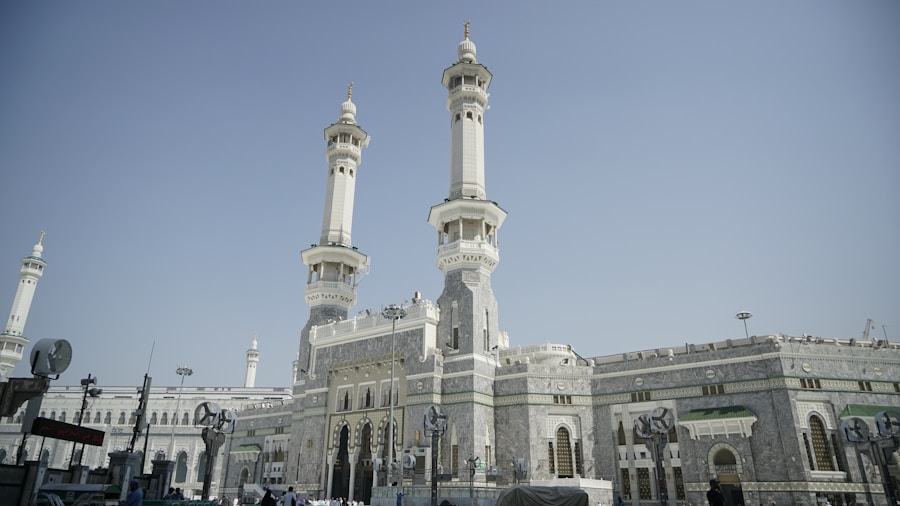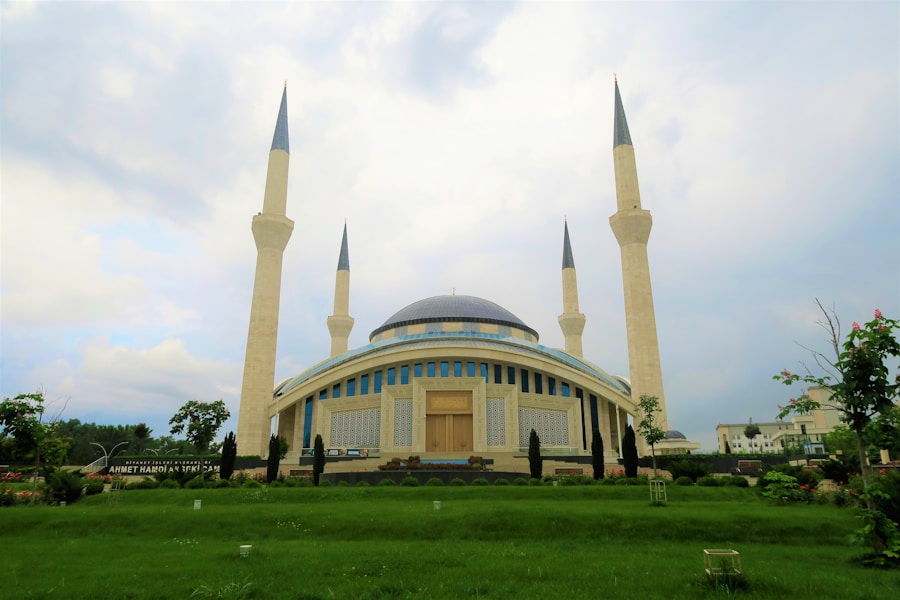Hajj and Umrah are two of the most significant pilgrimages in Islam, deeply rooted in the faith’s history and religious practices. Hajj, the greater pilgrimage, is obligatory for every Muslim who is physically and financially able to undertake it at least once in their lifetime. It takes place annually during the Islamic month of Dhu al-Hijjah, drawing millions of Muslims from around the globe to the holy city of Mecca.
The historical significance of Hajj can be traced back to the time of Prophet Ibrahim (Abraham), who is revered in Islam as a model of faith and obedience to God. According to Islamic tradition, Ibrahim was commanded by God to leave his wife Hagar and their infant son Isma’il (Ishmael) in the barren valley of Mecca. In her desperate search for water, Hagar ran between the hills of Safa and Marwah, a journey commemorated by the Sa’i ritual during Hajj.
The well of Zamzam, miraculously provided by God, symbolizes divine provision and mercy. Umrah, often referred to as the lesser pilgrimage, holds its own significance within Islamic tradition. While it is not obligatory, it is highly recommended and can be performed at any time of the year.
The rituals of Umrah are similar to those of Hajj but are less extensive. The historical roots of Umrah can be traced back to the practices of the Prophet Muhammad, who performed it both before and after the establishment of Hajj as a formal obligation. The act of performing Umrah is seen as a means of seeking forgiveness and spiritual renewal, allowing Muslims to connect with their faith in a profound way.
Both pilgrimages serve as reminders of the trials faced by Ibrahim and his family, reinforcing themes of sacrifice, devotion, and submission to God’s will.
Key Takeaways
- Hajj and Umrah hold great historical and religious significance in Islam, tracing back to the time of Prophet Ibrahim and his family.
- The rituals and practices of Hajj and Umrah involve specific acts of worship, such as Tawaf, Sa’i, and standing at Arafat, symbolizing the unity and submission to Allah.
- The spiritual journey of Hajj and Umrah is a deeply personal and transformative experience, allowing pilgrims to seek forgiveness, reflect on their lives, and strengthen their faith.
- Hajj and Umrah promote unity and equality in Islam, as people from all walks of life and different backgrounds come together to perform the pilgrimage as equals before Allah.
- The experience of Hajj and Umrah leads to personal and collective spiritual growth, fostering a sense of community, empathy, and compassion among Muslims.
The Rituals and Practices of Hajj and Umrah
The State of Ihram: Purity and Devotion
The rituals associated with Hajj are meticulously prescribed and encompass a series of actions that reflect obedience and devotion. The pilgrimage begins with the state of Ihram, a sacred condition that requires pilgrims to don simple white garments, symbolizing purity and equality before God. This state is not merely about physical attire; it represents a mental and spiritual readiness to engage in worship.
This act signifies the unity of believers in the worship of the One God, as they move together in harmony around the most sacred site in Islam. Following Tawaf, pilgrims engage in Sa’i, retracing Hagar’s desperate search for water between the hills of Safa and Marwah.
The Culmination of Hajj: Sacrifice and Charity
The culmination of Hajj occurs during the days of Eid al-Adha, when pilgrims participate in the symbolic act of Qurbani (sacrifice), commemorating Ibrahim’s willingness to sacrifice his son Isma’il in obedience to God’s command. This act not only reflects submission but also emphasizes charity, as the meat from the sacrifice is distributed among those in need.
Umrah: A Profound yet Accessible Pilgrimage
In contrast, Umrah consists of fewer rituals but carries profound spiritual significance. Pilgrims begin by entering into Ihram and performing Tawaf around the Kaaba, similar to Hajj. However, Umrah does not include the extensive rites associated with Hajj, making it more accessible for those unable to undertake the full pilgrimage. After Tawaf, pilgrims perform Sa’i between Safa and Marwah before concluding their pilgrimage with a symbolic act of shaving or cutting hair, representing spiritual renewal and humility before God.
The Spiritual Journey of Hajj and Umrah

The spiritual journey undertaken during Hajj and Umrah is transformative for many Muslims. It is often described as a pilgrimage that transcends mere physical travel; it is an inward journey that fosters deep reflection and connection with one’s faith.
This collective experience fosters an environment conducive to spiritual growth, as individuals engage in prayer, reflection, and acts of worship together. The journey begins long before reaching Mecca; it encompasses preparation that includes spiritual cleansing through prayer, fasting, and seeking forgiveness from others. Upon arrival in Mecca, pilgrims are enveloped in an atmosphere charged with spirituality.
The sight of the Kaaba evokes deep emotions, often leading to tears of joy and gratitude. Many pilgrims report feeling an overwhelming sense of peace and closeness to God during their time in this sacred space. The rituals performed during Hajj and Umrah serve as catalysts for personal transformation, encouraging individuals to confront their shortcomings and seek a renewed commitment to their faith.
Moreover, the spiritual journey does not end upon returning home; rather, it continues as pilgrims integrate their experiences into their daily lives. Many find themselves more attuned to their spiritual needs and more committed to practicing their faith with sincerity. The lessons learned during this pilgrimage often inspire individuals to engage in acts of kindness, charity, and community service upon their return.
The Unity and Equality in Islam through Hajj and Umrah
One of the most profound aspects of Hajj and Umrah is their ability to foster unity and equality among Muslims worldwide. Regardless of nationality, ethnicity, or social status, all pilgrims don the same simple white garments during Ihram, symbolizing their equality before God. This visual representation serves as a powerful reminder that in the eyes of Allah, all believers are equal; wealth, status, or background hold no significance in this sacred space.
The gathering of millions of Muslims from diverse cultures during Hajj exemplifies this unity on a global scale. Pilgrims come together to perform rituals side by side, sharing experiences that transcend linguistic and cultural barriers. This collective worship fosters a sense of brotherhood and sisterhood among participants, reinforcing the idea that Islam is a universal faith that transcends geographical boundaries.
The communal prayers at Masjid al-Haram further emphasize this unity as thousands stand shoulder to shoulder in worship. Moreover, this sense of equality extends beyond the pilgrimage itself; it influences how Muslims interact with one another in their daily lives. The lessons learned during Hajj and Umrah often inspire individuals to embrace diversity within their communities and promote inclusivity among fellow believers.
The shared experience of pilgrimage serves as a reminder that all Muslims are part of a larger ummah (community), bound together by faith.
The Personal and Collective Spiritual Growth through Hajj and Umrah
Hajj and Umrah offer unique opportunities for both personal and collective spiritual growth among Muslims. On an individual level, many pilgrims report experiencing profound transformations during their journeys. The act of leaving behind worldly distractions to focus solely on worship allows individuals to reconnect with their faith on a deeper level.
This process often leads to increased self-awareness and introspection as pilgrims confront their spiritual shortcomings and seek forgiveness for past transgressions. The collective aspect of these pilgrimages also plays a crucial role in fostering spiritual growth within communities. As pilgrims return home after completing Hajj or Umrah, they often share their experiences with family and friends, inspiring others to strengthen their own faith practices.
This ripple effect can lead to increased participation in communal prayers, charitable activities, and educational initiatives within local Muslim communities. Furthermore, many pilgrims find themselves motivated to engage in social justice efforts upon returning from their journeys. The lessons learned about compassion, humility, and service during Hajj and Umrah often translate into a desire to contribute positively to society.
This collective spiritual growth can lead to stronger bonds within communities as individuals come together to support one another in their faith journeys.
The Importance of Hajj and Umrah in the Five Pillars of Islam

The Five Pillars of Islam
These pillars include Shahada (the declaration of faith), Salah (prayer), Zakat (charity), Sawm (fasting), and Hajj (pilgrimage). While all five pillars are essential for a complete Islamic life, Hajj stands out due to its unique communal aspect and its requirement for those who are able.
The Significance of Hajj
The significance of Hajj is underscored by its inclusion as one of the Five Pillars; it represents not only an obligation but also an opportunity for spiritual elevation. By fulfilling this duty, Muslims demonstrate their commitment to their faith while also participating in a global expression of worship that unites millions across different cultures and backgrounds.
Hajj and Umrah: Complementary Practices
Umrah complements Hajj by providing an additional avenue for spiritual growth outside the obligatory pilgrimage. Although it is not one of the Five Pillars, its performance is highly encouraged as it allows Muslims to seek forgiveness and renewal at any time throughout the year. Together, Hajj and Umrah embody key aspects of Islamic practice: devotion, community engagement, humility before God, and an ongoing commitment to personal growth.
The Symbolism and Meaning of the Hajj and Umrah Rituals
The rituals associated with Hajj and Umrah are rich in symbolism and meaning, each designed to convey profound lessons about faith, obedience, and submission to God’s will. For instance, the act of Tawaf—circumambulating the Kaaba—symbolizes the unity of believers in worshiping Allah alone. As pilgrims move around this sacred structure together, they embody the concept that all Muslims are part of one community bound by shared beliefs.
The Sa’i ritual between Safa and Marwah serves as a poignant reminder of perseverance in seeking God’s mercy. It reflects Hagar’s unwavering faith during her search for water for her son Isma’il—a narrative that resonates deeply with many Muslims who face challenges in their own lives. This act encourages believers to trust in God’s provision even amidst adversity.
The symbolic act of Qurbani during Eid al-Adha further emphasizes themes of sacrifice and charity within Islam. By commemorating Ibrahim’s willingness to sacrifice his son out of obedience to God’s command, Muslims are reminded of the importance of selflessness and generosity towards others. This ritual not only reinforces individual piety but also fosters communal bonds through acts of charity as meat from sacrifices is distributed among those in need.
The Impact of Hajj and Umrah on the Muslim Community and the World
The impact of Hajj and Umrah extends far beyond individual pilgrims; it resonates throughout Muslim communities worldwide and even influences global perceptions of Islam. Each year, millions embark on these pilgrimages, contributing significantly to local economies in Mecca and Medina through tourism-related activities such as hospitality services, transportation, and retail businesses. Moreover, these pilgrimages serve as powerful reminders for Muslims about their shared identity as part of a global ummah.
As pilgrims return home with renewed faith and commitment to their beliefs, they often become ambassadors for Islam within their communities—sharing stories about their experiences that highlight values such as compassion, unity, humility, and service. On an international scale, Hajj has also fostered interfaith dialogue by showcasing Islam’s rich traditions rooted in spirituality rather than conflict or division. As non-Muslims observe or learn about these rituals through media coverage or personal interactions with Muslim friends or colleagues who have performed them—thereby dispelling misconceptions about Islam—they contribute positively towards building bridges between different cultures.
In conclusion, both Hajj and Umrah play vital roles not only within individual lives but also within broader societal contexts—shaping perceptions about Islam while fostering unity among believers across diverse backgrounds around shared values rooted deeply within faith traditions.
If you are interested in exploring spiritual significance in different locations, you may enjoy reading about the city of Philadelphia in this City Spotlight article. Just as Hajj and Umrah hold deep spiritual meaning for Muslims, visiting historical and cultural sites in Philadelphia can also provide a sense of connection and reflection.
FAQs
What is the spiritual significance of Hajj and Umrah in Islam?
Hajj and Umrah are both important pilgrimages in Islam that hold great spiritual significance for Muslims. They are acts of worship that demonstrate submission to Allah and serve as a means of seeking forgiveness and spiritual purification.
What is the difference between Hajj and Umrah?
Hajj is a mandatory pilgrimage that must be performed at least once in a lifetime by every able-bodied and financially capable Muslim, while Umrah is a non-mandatory pilgrimage that can be performed at any time of the year.
What are the rituals involved in Hajj and Umrah?
Hajj involves a series of rituals including Tawaf (circumambulation) around the Kaaba, Sa’i (walking) between the hills of Safa and Marwah, and standing in Arafat. Umrah also includes Tawaf and Sa’i, but does not include the standing in Arafat.
What are the spiritual benefits of performing Hajj and Umrah?
Performing Hajj and Umrah is believed to bring numerous spiritual benefits, including the forgiveness of sins, the opportunity for self-reflection and self-improvement, and the strengthening of faith and connection to Allah.
How does performing Hajj and Umrah contribute to the unity of the Muslim community?
Hajj and Umrah bring together Muslims from all over the world, regardless of their race, ethnicity, or social status, to perform the same rituals in the same sacred places. This fosters a sense of unity and equality among the Muslim community.



0 Comment